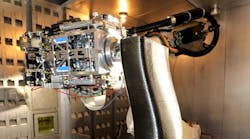Electronic safety systems are rapidly becoming major parts of modern automotive vehicles, steering toward a future of roadways filled with autonomous vehicles. Advanced driver-assistance systems (ADAS) based on radar and electronic communications circuits are promising safer future roadways. Crafting these systems requires high-frequency electronic components, such as RF/microwave printed-circuit-board (PCB) antennas for automotive radar sensors and for various forms of communications between vehicles. In turn, fabricating effective components requires suitable circuit materials.
Increased reliance on high-frequency electronics can help pave safer roadways for the future. At present, more than 1.25 million automobile-related deaths occur each year globally, with another 50 million people injured. Improving traffic safety is a key motivation for expanding the ADAS functions of vehicles.
New Car Assessment Program (NCAP) organizations in several countries and regions have established car safety roadmaps, challenging automobile manufacturers to improve safety functions to earn NCAP top vehicle safety ratings. Mobility as a Service (MaaS) is also emerging as a market to provide consumers affordable transportation options versus personal vehicle ownership, which also frees passengers to convert their driving time to higher value activities.
ADAS systems such as millimeter-wave (mmWave) radar sensors help to improve the safety of commercial automotive vehicles and, as such, are graded by the Society of Automotive Engineers (SAE) in terms of six levels of vehicle autonomy, from Level 0 (no automation) to Level 5 (full automation). Many organizations focused on increasing vehicle safety approach vehicle automation from the ground (Level 0) up, while organizations interested in developing autonomous vehicles have great interest in Level 4 or 5 automation, where a driver becomes more of a passenger.
Whatever the level of vehicle safety required, multiple sensors are needed for a reliable, full 360-deg. view of a vehicle’s environment. Electronic devices contributing to that full view include light detection and ranging (LiDAR) sensors, cameras, radar, Global Positioning System (GPS) receivers, and vehicle-to-everything (V2X) communications systems. Radar sensors are important ADAS components since they can measure the distance, velocity, and angular position of targets near a vehicle.








